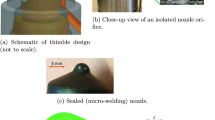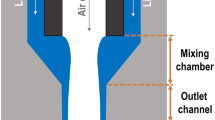Abstract
Vortices generation and flow dynamics are investigated by a numerical calculation with LES methodology on the evaporative surface including chemical reactions. For simplicity, fuel is radially injected from the surface in order to decouple pyrolysis of solid fuel from the governing equation and consideration of heat transfer balance. Nevertheless its simple treatment of chemical reactions and fuel pyrolysis, numerical results captured very fundamental understandings in terms of averaged temperature, velocity profile, and mixture fraction distribution. Results showed that a well-defined turbulent velocity profile at the inlet becomes twisted and highly wrinkled in the downstream reaching the maximum velocity at far above the surface, where the flame is located. And the thickness of boundary layer increases in the downstream due to the enhanced interaction of axial flow and mass injection from the surface. Also, chemical reaction appears highly active and partially concentrated along the plane where flow condition is in stoichiometric. In particular, flame front locates at the surface where mixture fraction Z equals to 0.07. Flame front severely wrinkles in the downstream by the interaction with turbulences in the flow. Partial reactions on the flame front contribute to produce hot spots periodically in the downstream attaining the max temperature at the center of each spot. This may take the role of additional unsteady heat generations and pressure perturbations in the downstream. Future study will focus on the evolution of hot spots and pressure perturbations in the post chamber of lab scale hybrid rocket motors.
Similar content being viewed by others
References
C. Carmicino, Acoustics, vortex shedding, and low-frequency dynamics interaction in an unstable hybrid rocket, Journal of Propulsion and Power, 25 (6) (2009) 1322–1335.
A. Bettella, M. Lazzarin, N. Bellomo, F. Barato and D. Pavarin, Testing and CFD simulation of diaphragm hybrid rocket motors, 47th AIAA/ASME/SAE/ASEE Joint Propulsion Conference and Exhibit, San Diego, California, USA (2011) 2011–6023.
Y. Na and C. Lee, Large eddy simulation of flow development in chamber with surface mass injection, Journal of Propulsion and Power, 25 (1) (2009) 51–59.
B. Kim, Y. Na, K. H. Shin and C. Lee, Nonlinear combustion and fluid mechanics in a hybrid rocket, Journal of Propulsion and Power, 28 (6) (2012) 1351–1358.
V. Novozhilov, P. Josep, K. Ishiko, T. Shimada, H. Wang and J. Liu, Polymer combustion as a basis for hybrid propulsion: A comprehensive review and new numerical approaches, Energies, 4 (10) (2011) 1779–1839.
Y. Funami and T. Shimada, Validation with experiments on simplified numerical prediction of hybrid rocket internal ballistics, AIP Conf. Proc, Vienna, Austria (2012) 1493:395.
A. Coronetti and W. A., Sirignano, Numerical analysis of hybrid rocket combustion, Journal of Propulsion and Power, 29 (2) (2013) 371–384.
N. Peters, Turbulent combustion, Cambridge University Press, Cambridge, UK (2000).
A. W. Cook and J. J. Riley, A subgrid model for equilibrium chemistry in turbulent flows, Physics of Fluids, 6 (1994) 2868–2870.
C. D. Pierce and P. Moin, A dynamic model for subgridscale variance and dissipation rate of a conserved scalar, Physics of Fluids, 10 (1998) 3041–3044.
GRI-Mech 3.0, The Gas Research Institute, http://www.me.berkeley.gru/gri_mech/ .
H. Koo, K. Mon and C. Lee, The effect of a block on the flow oscillations near the fuel surface with wall blowing, 48th AIAA/ASME/SAE/ASEE Joint Propulsion Conference and Exhibit, Atlanta, Georgia, USA (2012) 2012–4108.
G. Gariani, F. Maggi and L. Galfetti, Numerical simulation of HTPB combustion in a 2D hybrid slab combustor, Acta Astronautica, 69 (5) (2011) 289–296.
S. Yuasa, T. Ide, M. Masugi, T. Sakurai, N. Shiraishi and T. Shimada, Visualization and emission spectra of flames in combustion chamber of swirling-oxidizer-flow-type hybrid rocket engines, Journal of Thermal Science and Technology, 6 (2) (2011) 268–277.
Author information
Authors and Affiliations
Corresponding author
Additional information
Recommended by Associate Editor Kyu Hong Kim
Changjin Lee received his Ph.D. from University of Illinois at Urbana-Champaign in 1992. Dr. Lee is currently a Professor in the department of Aerospace Engineering at Konkuk University in Korea. His research interests include combustion instabilities of hybrid, liquid rocket and jet propulsions.
Charyeom Park holds a bachelor degree in Aerospace Engineering from Konkuk University, Seoul, Korea in 2013. Currently, he is a graduate student seeking for the master degree. His research interests include computational fluid dynamics.
Rights and permissions
About this article
Cite this article
Park, C., Lee, C. Vortices generation in the reactive flow on the evaporative surface. J Mech Sci Technol 29, 563–570 (2015). https://doi.org/10.1007/s12206-015-0116-z
Received:
Revised:
Accepted:
Published:
Issue Date:
DOI: https://doi.org/10.1007/s12206-015-0116-z




